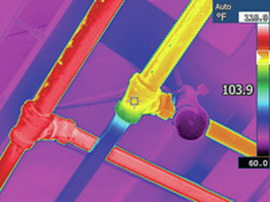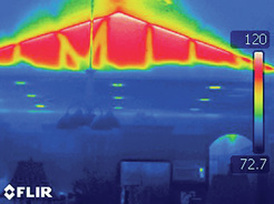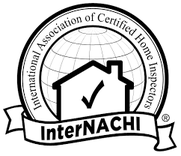Frequently Asked Questions

When and why do I need a home inspection?
Your home will most likely be the largest investment you’ll ever make. A home inspection will discern and minimize unpleasant surprises and unexpected difficulties that may come with a new or pre-owned home before making an investment. When buying a home the inspection identifies any visually observed material defects of the roof, exterior, attic, foundation, crawlspace & structure, heating, cooling, plumbing, electrical, fireplace, attic & insulation, doors, windows & interior areas and more. If you already own the home, a home inspection can detect arising problems and make suggestions of preventive measures to assist you in diminishing future costly repairs. When your planning to sell your home, a home inspection offers you the opportunity to detect areas of concern and make repairs before listing to ensure it is in better selling condition.
Do I need to be there for the inspection?
It is not required but is recommended. By being there, you can observe the inspector and ask questions for a better understanding of the conditions of the home.
What if the inspection and report shows problems?
No home is perfect. When problems are identified and disclosed it will give you a better understanding of the home and don't be discouraged from the purchase. It will assist you in evaluating the homes overall condition, your budget and your expectations of the investment.
Your home will most likely be the largest investment you’ll ever make. A home inspection will discern and minimize unpleasant surprises and unexpected difficulties that may come with a new or pre-owned home before making an investment. When buying a home the inspection identifies any visually observed material defects of the roof, exterior, attic, foundation, crawlspace & structure, heating, cooling, plumbing, electrical, fireplace, attic & insulation, doors, windows & interior areas and more. If you already own the home, a home inspection can detect arising problems and make suggestions of preventive measures to assist you in diminishing future costly repairs. When your planning to sell your home, a home inspection offers you the opportunity to detect areas of concern and make repairs before listing to ensure it is in better selling condition.
Do I need to be there for the inspection?
It is not required but is recommended. By being there, you can observe the inspector and ask questions for a better understanding of the conditions of the home.
What if the inspection and report shows problems?
No home is perfect. When problems are identified and disclosed it will give you a better understanding of the home and don't be discouraged from the purchase. It will assist you in evaluating the homes overall condition, your budget and your expectations of the investment.
______________________________

What is the cost of the inspection?
The inspections and thermography fees vary depending on the size of the home.
While our fees are competitive, cost should not be a leading factor in the selection of an inspector. The sense of security and awareness gained from the home inspection is worth the cost and the lowest price is not always a bargain.
What is Notice of Acceptance (NOA)?
A Notice of Acceptance or NOA is approval notice issued by the Building Code Compliance Office of Miami-Dade, Florida.
What is Miami-Dade Certified Impact Resistant Product?
These are products that undergone rigorous testing in compliance with TAS protocols. Certified products will received a NOA number bearing the product approval.
The inspections and thermography fees vary depending on the size of the home.
While our fees are competitive, cost should not be a leading factor in the selection of an inspector. The sense of security and awareness gained from the home inspection is worth the cost and the lowest price is not always a bargain.
What is Notice of Acceptance (NOA)?
A Notice of Acceptance or NOA is approval notice issued by the Building Code Compliance Office of Miami-Dade, Florida.
What is Miami-Dade Certified Impact Resistant Product?
These are products that undergone rigorous testing in compliance with TAS protocols. Certified products will received a NOA number bearing the product approval.
______________________________

How does thermal imaging work?
Thermal imaging depicts infrared light energy (aka radiant heat) emitted, transmitted or reflected by any objects creating a picture of temperature. The thermal images show the surface temperature data converted into a corresponding map of colors. Since it is a picture of temperature emissions rather than visible light, objects are made noticeable even in the dark, through thick smoke, dust, and fog. GGTI's thermal evaluation or scan will include pictures of the heat patterns and temperature variations of your homes building envelope (ceilings, walls, windows, doors, and floors), circuit breakers, switch plates, exposed plumbing and more. These images are able to easily and non-invasively depict and pinpoint developing or existing problems in your home or property of interest. Certain heat signatures of your homes’ interior may indicate energy loss, moisture intrusion, pest infestations, gaps in insulation and more. Most thermal deficiencies (the sources of energy loss, the causes of residents discomfort and feasible safety issues) are relatively easy and inexpensive to fix if caught early. The image above is of a vaulted ceiling, the client was told that insulation was installed. The IR scan made evident the lack of insulation.
Is infrared thermal imaging new technology?
No, infrared thermal imaging technology has been around for many years. However, various beneficial applications are still emerging.
Can thermal imaging see through walls and other materials?
No, thermal imaging cannot “see through” walls or other materials. Thermal imaging measures the surface temperature of objects. Some materials may be affected by the heat emitted, transmitted or reflected by other objects.
Check out the video below!
Thermal imaging depicts infrared light energy (aka radiant heat) emitted, transmitted or reflected by any objects creating a picture of temperature. The thermal images show the surface temperature data converted into a corresponding map of colors. Since it is a picture of temperature emissions rather than visible light, objects are made noticeable even in the dark, through thick smoke, dust, and fog. GGTI's thermal evaluation or scan will include pictures of the heat patterns and temperature variations of your homes building envelope (ceilings, walls, windows, doors, and floors), circuit breakers, switch plates, exposed plumbing and more. These images are able to easily and non-invasively depict and pinpoint developing or existing problems in your home or property of interest. Certain heat signatures of your homes’ interior may indicate energy loss, moisture intrusion, pest infestations, gaps in insulation and more. Most thermal deficiencies (the sources of energy loss, the causes of residents discomfort and feasible safety issues) are relatively easy and inexpensive to fix if caught early. The image above is of a vaulted ceiling, the client was told that insulation was installed. The IR scan made evident the lack of insulation.
Is infrared thermal imaging new technology?
No, infrared thermal imaging technology has been around for many years. However, various beneficial applications are still emerging.
Can thermal imaging see through walls and other materials?
No, thermal imaging cannot “see through” walls or other materials. Thermal imaging measures the surface temperature of objects. Some materials may be affected by the heat emitted, transmitted or reflected by other objects.
Check out the video below!
_____________________________________

Can thermal imaging detect moisture/mold?
While thermal imaging is not a moisture meter or radar technology to detect mold, it does make moisture that may be otherwise hidden in finished ceilings and walls, apparent in thermal images by a change in normal temperature patterns in a home.
How often does my home need an infrared thermal inspection?
Once a year or two to catch any possible developing issues, like air infiltration and moisture intrusion, electrical faults or mechanical overloads, at the earliest stages to minimize damage, cost, energy waste and to ensure your family’s safety. We also recommend a thermal imaging evaluation after any natural disasters (ex. after a hurricane even if there is not any visible damage) or after any accidents (ex. if a tree fell on your roof). The image to the left reveals a blocked plumbing line that would have been a costly repair if not detected at the correct location.
While thermal imaging is not a moisture meter or radar technology to detect mold, it does make moisture that may be otherwise hidden in finished ceilings and walls, apparent in thermal images by a change in normal temperature patterns in a home.
How often does my home need an infrared thermal inspection?
Once a year or two to catch any possible developing issues, like air infiltration and moisture intrusion, electrical faults or mechanical overloads, at the earliest stages to minimize damage, cost, energy waste and to ensure your family’s safety. We also recommend a thermal imaging evaluation after any natural disasters (ex. after a hurricane even if there is not any visible damage) or after any accidents (ex. if a tree fell on your roof). The image to the left reveals a blocked plumbing line that would have been a costly repair if not detected at the correct location.
